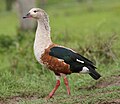| Neochen | |
|---|---|
 | |
| Orinoco goose, Neochen jubata | |
| Scientific classification | |
| Kingdom: | Animalia |
| Phylum: | Chordata |
| Class: | Aves |
| Order: | Anseriformes |
| Family: | Anatidae |
| Subfamily: | Tadorninae |
| Genus: | Neochen Oberholser, 1918 |
| Type species | |
| Anser jubatus [1] Spix, 1825 | |
| Species | |
Neochen is a genus of birds in the family Anatidae.


